Headaches of all kinds are truly a day-killer and can take a toll on work and family life. 14.2% of Americans 18 or older report having some type of headache within a 3 month period and headache pain is the 4th leading cause for emergency room visits. (1) It’s a huge health problem, to say the least! Wouldn’t it be great if treating a migraine didn’t mean needing to take drugs or missing productive days in your life? Upper cervical chiropractic care may be just the relief you’re looking for.
Let’s take a look at the most common types of headaches:
Tension Headaches: Notably the most common with 30-70% of the population experiencing this type of headache. (2) The stress consuming the modern world contributes to its prevalence.

Tension Headache
Common causes include:
- Emotional stress
- Computer/screen time
- Dehydration
Symptoms include:
- Stiffness and tenderness in neck muscles
- Pressure like a vice around the entire head including the back of the head
- Tension and pain in the upper shoulders
Cervicogenic Headaches: Cervicogenic headaches affect both men and women, with women slightly more often. They tend to be mistaken for migraines, but are more moderate in nature and manifest from the neck and move upward into the head. However, they have been known to cause episodes of nausea/vomiting, dizziness, and sensitivity to light and sound the longer the episode lasts.

Cervicogenic Headache
Common causes include:
- Degeneration of the cervical spine
- Poor posture, specifically forward head posture
- Strenuous activities
- History of whiplash injury
Symptoms include:
- Dull, moderate pain in the neck and back and top of the head
- Reduced range of motion and flexibility of the neck
- Blurred vision
- Pain on down arms and on top and between shoulder blades
Migraine Headaches: Typically these affect women more than men. The literature shows that migraines affect the cranial vascular system which makes these exceptionally debilitating.(3) In some cases they can last for up to 72 hours and cause significant strain on the work-life balance.

Migraine Headache
Common causes include:
- Weather changes
- Hormones
- Dehydration
- Stress
- Low blood sugar
- Lack of sleep
Symptoms include:
- Nausea/vomiting
- Vision issues
- Sensitivity to light/sound
- Dizziness/vertigo
- Throbbing, unrelenting pain on one side of the head
Rebound Headaches: Also called Medication Overuse Headaches (MOH) and these typically occur with migraine sufferers. The more intense or frequent migraines become, the more medication is used and in these situations, the migraine can come back with a vengeance or become a long, dull tension headache that never seems to go away no matter what you do. In these cases, finding an alternative treatment when your medication is actually causing your symptoms to become worse or longer-lasting may be your answer!

Rebound Headache
Common causes include:
- Regular, long term use of headache medications
Symptoms include:
- A headache that recurs every day or nearly every day
- Nausea
- Restlessness
- Difficulty concentrating
- Memory problems
- Irritability
Sinus Headaches: Some sinus headaches do have similar symptoms of migraines but have some distinct differences.

Sinus Headache
Common causes include:
- Infection
- Common cold
- Allergies
Symptoms include:
- Fever
- Stuffy/runny nose
- Pressure/pain behind eyes
- Pain in top teeth
- Ear pain/fullness
Post-Concussion Headaches: Long after the onset of initial symptoms of concussion subside, headaches can persist. In any head injury situation, the neck, especially the upper cervical region (C1/C2), is very vulnerable to damage. These types of headaches often come with other disturbing and debilitating symptoms (3).
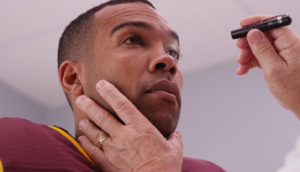
Post-Concussion Headache
Common causes include:
- A blow to the head that causes a traumatic brain injury
Symptoms include:
- Insomnia
- Concentration difficulties
- Mood changes
- Depression/anxiety
- Visual disturbances
A concussion is a head injury, so why is the upper part of the spine so important? When the atlas (C1) misaligns it impairs the brainstem’s function and alters proper communication between the brain and body.
Headaches are very common in post-concussion sequela. Two studies, one with 452 and another with 212 people, showed a headache rate of 58%. (8)
Typically we see that blood flow to the brain is hampered due to an atlas misalignment. C1 has openings on either side of the vertebrae for the vertebral artery to pass bringing oxygen-rich blood to the brain. If the atlas is misaligned, this will seriously impair this process causing many of the symptoms described.
One of the most significant observations in post-concussion syndrome is reduced cerebrospinal fluid drainage. An upper cervical misalignment causes a “bottleneck” reducing proper flow and drainage and can eventually cause chronic intracranial pressure not only causing severe headaches, but other chronic conditions can also eventually occur. (5)
Cluster Headaches: Cluster headaches cause severe, piercing pain behind one eye, and attacks can last from only 15 minutes for up to 3 hours but can occur several times per day for many days in a row. This is one reason why this type of headache is often called the “Suicide Headache”. Suffers are often exhausted after an attack simply due to the magnitude of pain it causes.
Common causes include:
- Mostly in men
- Smoking
- Alcohol
- Changes in sleep patterns
Symptoms include:
- Pain, swelling, and drooping in and around one eye
- Tearing of the eye
- Runny or congested nose
- Red, warm face
- Sweating
Can a chiropractor help a headache?
How is it that upper cervical chiropractic techniques can provide relief for so many different types of headaches? Well, the answer is that it is SPECIFIC!
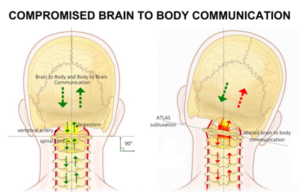
Compromised brain-body communication at the upper cervical spine.
Research shows that headaches are often linked to a misaligned atlas—the top bone in the spine. A misalignment causes tension in the spinal cord and the disruption of the brain’s ability to communicate with the body. This affects the body’s normal functions such as the flow of blood or spinal fluid (5). The pressure associated with the misalignment can cause tension leading to different types of headaches depending on what tissues are most affected.
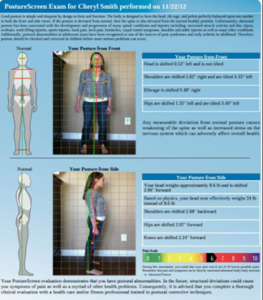
Postural Evaluation showing distortions from spinal stress.
Our trained upper cervical chiropractors take great care in the consultation, examination, and diagnostic portion of your care before your first alignment. What are the diagnostic tools that an upper cervical chiropractor might use? (6)
- Palpation is key in knowing what areas of the spine are moving properly and which ones are not. Muscle tension and tenderness are also key for a clear understanding of how these misalignments are affecting the entire musculoskeletal system.
- Postural assessments are used to determine asymmetry and what muscle groups are most affected when the atlas is out of alignment. The use of pre and post-postural assessments can help our chiropractors decide what muscle groups need specific exercises to help strengthen and correct abnormal posture. Each patient in our office receives these exercises based on their post-alignment posture assessment, so our recommendations are unique to each patient.
- Leg length inequality is checked while you are lying on your back and is one of the first neurological signs that the atlas may be out of alignment. This is typically not a true anatomical “short leg”, but a functional short leg due to the atlas misalignment. An atlas misalignment causes a drawing up and torsion of the hip causing one leg to appear shorter. Imagine walking, running, sitting, and even sleeping with one side of your body completely unbalanced and your muscles working harder on one side more than the other, day in and day out.
Posture plays a significant role in the cause of headaches and migraines, especially forward head posture. Due to the use of mobile phones and constant computer use, forward head posture has become an epidemic, and coupled with an atlas misalignment, the chance of a headache or migraine recurring exponentially increases.
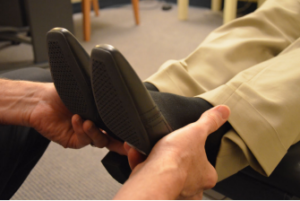
Functional Short Leg Check.
Can bad posture cause headaches?
It’s easy to understand why poor posture can contribute to headaches and migraines, but why is the upper cervical region (Atlas/C1) so important to maintain proper posture? Let’s nerd out for a moment…
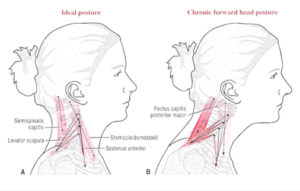
Head forward posture creates tension in the neck, shoulders, and head.
The atlas surrounds a portion of the brainstem. Because of its unique connection to the brainstem via the dentate ligaments, it can stress and even deform the brainstem when the atlas or craniocervical junction misaligns. This is called the Dentate Ligament-Cord Distortion Hypothesis that was first presented by Dr. John Grostic, DC. (4)
When the atlas misaligns, due to trauma, repetitive stress, or even emotional stress, this affects the part of the brainstem that controls all of your postural muscles, particularly, the spinocerebellar tracts and reticulospinal pathway arising from the lateral part of the mesopontine tegmentum and spinal locomotor network in the brainstem that contributes to this process. The figure below shows this phenomenon in detail.
-Precision films are taken which provides a specific “listing” or vectors that pertain to how your misalignment needs to be corrected. In most cases, immediately following the initial adjustment of the atlas, post films are taken to note the amount of correction. This allows our doctors to “fine-tune” the adjustment and get an even more precise alignment the next time you need an atlas adjustment.
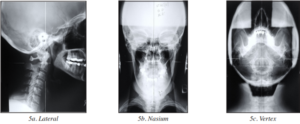
Orthospinology Upper Cervical Precision Xrays.
An upper cervical adjustment can be done by hand, a handheld instrument, or a table-mounted instrument to perform the adjustment. In our office, we use the handheld instrument. It allows us to perform not only a precision adjustment but one that uses only a gentle tap.
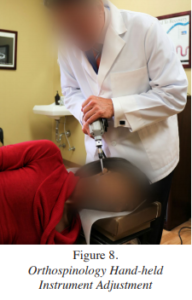
Orthospinology Upper Cervical Atlas/C1 adjustment.
Upper cervical chiropractic is gentle, yet powerful enough to relieve even the worst headache conditions and not just temporarily. Most patients have long-lasting relief as long as their alignment holds, which is the goal of our upper cervical chiropractors!
References:
- Burch RC, Loder S, Loder E, Smitherman TA. The prevalence and burden of migraine and severe headache in the United States: updated statistics from government health surveillance studies. Headache. 2015 Jan;55(1):21-34. doi: 10.1111/head.12482. Erratum in: Headache. 2015 Feb;55(2):356. PMID: 25600719.
- Vernon H, McDermaid C. Chiropractic management of episodic tension-type headache: a survey of clinical specialists. J Can Chiropr Assoc. 1998;42(4):209-215.
- Ryan LM, Warden DL. Post-concussion syndrome. Int Rev Psychiatry. 2003 Nov;15(4):310-6. doi: 10.1080/09540260310001606692. PMID: 15276952.
- Eriksen K, Upper cervical subluxation complex: a review of the chiropractic and medical literature. Baltimore, MD; Lippincott Williams and Wilkins 2003
- Damadian RV, Chu D. The possible role of cranio-cervical trauma and abnormal CSF hydrodynamics in the genesis of multiple sclerosis. Physiol Chem Phys Med NMR. 2011;41:1-17. PMID: 21970155.
- Charles Woodfield, D. Gordon Hasick, Werner J. Becker, Marianne S. Rose, James N. Scott, “Effect of Atlas Vertebrae Realignment in Subjects with Migraine: An Observational Pilot Study”, BioMed Research International, vol. 2015, Article ID 630472, 18 pages, 2015. https://doi.org/10.1155/2015/630472
- Woodfield HC 3rd, York C, Rochester RP, Bales S, Beebe M, Salminen B, Scholten JN. Craniocervical chiropractic procedures – a précis of upper cervical chiropractic. J Can Chiropr Assoc. 2015 Jun;59(2):173-92. PMID: 26136610; PMCID: PMC4486989.
- Moore, J. (2019). CHIROPRACTIC MANAGEMENT OF THE CRANIOCERVICAL JUNCTION IN POST-CONCUSSION SYNDROME: A CASE SERIES. Journal of Contemporary Chiropractic, 2(1), 92-102.